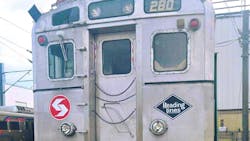NTSB urges SEPTA to suspend Silverliner IV trains over repeated fire risks
The National Transportation Safety Board (NTSB) is urging the Southeastern Pennsylvania Transportation Authority (SEPTA) to eliminate fire risks that are associated with the agency’s Silverliner IV railcars.
According to the NTSB, the railcars present a safety risk to riders due to the outdated design of the railcars, in combination with SEPTA's maintenance and operating practices that have failed to protect passengers and crews because defective railcars have been kept in passenger service. The NTSB notes the risks posed by the design cannot be fully addressed without an extensive fleet retrofit or replacement.
The NTSB recommends SEPTA:
- Suspend operation of the Silverliner IV fleet until the agency determines the root causes of fires, develops and implements a plan to address these causes and identifies and corrects the organizational factors that have prevented effective risk mitigations.
- Implement a plan to monitor the success of its risk-mitigation approach to the Silverliner IV fleet, including provisions for immediately removing the fleet from service again if its mitigations fail to prevent fires.
- Create an expedited procurement or retrofit schedule and seek funding from appropriate sources as soon as possible to accelerate the replacement of the Silverliner IV fleet or its retrofit to include modern feedback systems and meet federal fire safety standards for new railcars.
The recommendations follow the NTSB’s investigation of a Feb. 6 fire in Ridley Park, Pa., as well as four other Silverliner IV fires during the past three months, including one in Philadelphia on Sept. 25. The NTSB says the recurrence of fires shows organizational lapses that block effective risk mitigation and that the agency’s proposed changes to its operations, maintenance and engineering activities require ongoing monitoring to ensure they protect passengers and crews.
The full report is available on NTSB’s website.
SEPTA’s response to the NTSB
In response to the NTSB report, SEPTA has added the following safety measures throughout its rail system:
- In-person inspectors on all trains going through Center City stations.
- Adding mid-run inspections of fault indicator lights, in addition to other checks and inspections already in place.
- Live video monitoring that allows SEPTA’s Control Center supervisors to look into all trains to check on the indictor lights.
“Safety of our customers is our top priority,” said SEPTA General Manager Scott Sauer during a press conference on Oct. 2 while pointing out that the railcars are not only the oldest in the agency’s fleet, but they are also one of the oldest railcars in the U.S.
SEPTA says that due to funding constraints that it has had to keep the rail cars in service long beyond their recommended useful life. The agency says it is developing a funding plan to support their replacement despite ongoing funding challenges.
According to the agency, operations staff will continue to remove railcars from service that are displaying any indicators that have been identified as possible root causes of previous fire incidents. Over the next month, SEPTA will be removing Silverliner IV railcars from service for inspections.
“We are confident these trains are safe, and we are also confident that our mitigation efforts will allow us to maintain safe service for our customers moving forward,” Sauer added.
Federal Railroad Administration (FRA) issues emergency order
Along with the NTSB’s recommendations, the FRA issued an emergency order that requires SEPTA to take action within seven days to reduce the risk of additional fires. Those actions include:
- Develop a plan to determine the direct and contributing causes of each fire or thermal incident that has occurred in 2025 and identify the root causes, circumstances, personnel, funding or other conditions that have caused the fires and thermal incidents to occur in this period. The Emergency Order says SEPTA shall implement the plan and provide FRA with a written report of its findings no later than Oct. 30, 2025.
- Prepare and submit to FRA for approval an emergency mechanical inspection schedule of each Silverliner IV electric multiple unit (EMU). The order requires each Silverliner IV EMU in SEPTA’s fleet be removed from service to complete a comprehensive inspection including, but not limited to, high-voltage control systems, propulsion system and dynamic brake system, HVAC system, components and elements of safety and warning systems, high- and low-voltage cables, harnesses and connectors and the condition of terminals and lugs, as well as any associated peripheral systems.
- Review its inspection, testing and maintenance (ITM) plan and submit the plan to FRA with proposed amendments sufficient to ensure that mechanical failures of the type leading to fires or thermal incidents will be detected and repaired.
- Update, as needed, SEPTA Supplemental Division Notice Number 7-20C and any other relevant operating rule to implement the requirements of this order.
- Require by issuance of a written notice to train crews that every engineer report any sluggish or poor performance of braking or acceleration or any anomalous vehicle behavior to the dispatcher within five minutes of the event.
- Complete a stand-down and debriefing with every mechanical employee involved with the inspection, troubleshooting, maintenance or repair of Silverliner IV EMUs to include review of all fire and thermal incidents, the known direct and indirect causes and to solicit feedback from the employees to identify improvements that SEPTA can make in its maintenance programs and practices.
- Conduct random quality audits of the performance of the mechanical department’s completion of repair and maintenance work items. Audits must occur every day and cover more than one shift each day.
The emergency order also gives SEPTA 30 days to take the below additional measures:
- Complete all actions under the emergency mechanical inspection schedule that has been approved by FRA, including inspection of all Silverliner IV EMUs for precursor conditions that increase the likelihood of a fire or thermal incident.
- Install thermal protection circuits at all critical locations on every Silverliner IV EMU to shut down propulsion and auxiliary circuits if higher than normal operating temperatures are detected.
- Document all inspections and repairs made to the Silverliner IV EMU fleet and present a graphical depiction of significant defects identified to the employees performing the work to clearly show to the employees leading and trailing indicators.
- Review all technical documents such as repair procedures, part lists, bills of materials, maintenance and modification instructions, tooling and inventory requirements and revise as needed to ensure all are up to date.
- Ensure that the mechanical department reviews and updates employee training requirements and proficiency tests to address any deficiency identified in the implementation of this Order.
- Complete, or cause to be completed, a comprehensive update of all root cause analyses begun in response to fire or thermal incidents and develop a corrective action plan to prevent their recurrence and implement continuous monitoring of mechanical systems performance.
- Comply with all requirements of the revised ITM plan submitted to and approved by the FRA.
“At my direction, FRA is taking swift and immediate action to ensure the safety of all passengers and transit workers on SEPTA,” said U.S. Department of Transportation Secretary Sean Duffy. “This includes deploying our team of experts to SEPTA’s trains, repair shops, dispatch center, to ensure thorough safety precautions are being implemented. Recent fires and ongoing mechanical problems are unacceptable to such a critical rail line. Under President [Donald] Trump, we will always put the safety of the American people first. SEPTA must take action to correct these persistent dangers.”
About the Author
Brandon Lewis
Associate Editor
Brandon Lewis is a recent graduate of Kent State University with a bachelor’s degree in journalism. Lewis is a former freelance editorial assistant at Vehicle Service Pros in Endeavor Business Media’s Vehicle Repair Group. Lewis brings his knowledge of web managing, copyediting and SEO practices to Mass Transit Magazine as an associate editor. He is also a co-host of the Infrastructure Technology Podcast.

